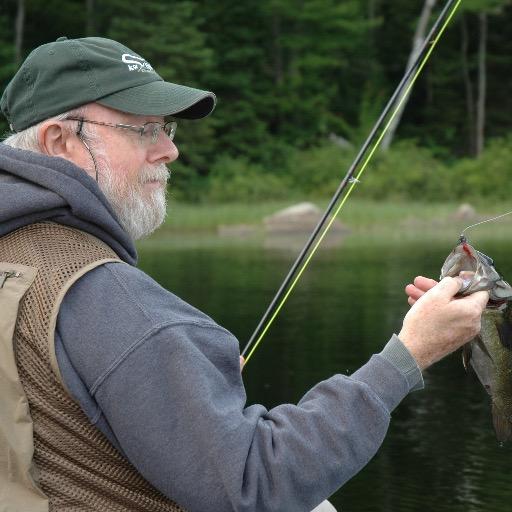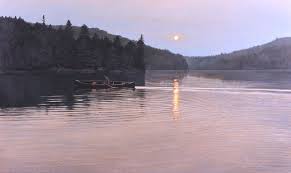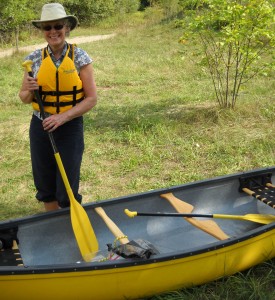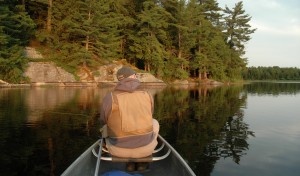I haven’t done as much canoeing as I would have liked over my six and a half decades on the planet. For example, I’ve never gone wilderness-tripping. However, I have canoed since camping as a youngster. My partner Lois canoed growing up during summers at her family cottage on Lake of Bays. For a couple of years she owned a yellow canoe. As an avid fly angler, I like fishing from a canoe on a lake almost as much as wading rivers. I also enjoy the canoe through books, music and the visual arts. In my imagination, the canoe is connected to my deep love of fresh water — streams, rivers and lakes.
My interest in both the canoe and canoeing has made the annual KW Canoe Symposium a must-attend event every spring since its inception five years ago.
It’s impossible to imagine Canada without the canoe. It’s not an exaggeration to refer to this vast country of ours as Land of the Canoe.
The canoe is more than an effective means of transportation — a harmonious blend of form and function, history and geography, design and craft — ideally adapted to the landscape. It played a critical role in nation building by shaping the country through exploration and settlement, trade and commerce, war and recreation, sport and art. It’s a link between First Nations people and European pioneers. As image, metaphor and symbol it finds expression through story, poetry and song, drawing, painting and sculpture.
Waterloo elementary school teacher and avid canoeist David Blain is the founder of the canoe symposium which returns to Waterloo’s Princess Twin on April 16. As in the previous four years, it’s sold out.
Blain’s objective is as simple and elegant as the canoe’s design: ‘To raise awareness about something with deep cultural roots in this country that has remained a central element in our identity,’ he once told me in an interview.
To serve that end, the symposium is a forum for canoeists ‘to share their love of the rich cultural heritage’ and rewarding wilderness experience canoeing provides. ‘The canoe is in danger of becoming a curiosity in our fast-paced 21st century,’ Blain cautions on his website. ‘Yet those who share a passion for wilderness know that the best way to truly experience what is left of Canada’s once endless wilderness is under your own power. . . by canoe.’ He adds ‘the event [offers] an opportunity to celebrate this unique craft and its continuing relevance to modern Canadians.’
Blain has no desire to exploit the growing popularity of so-called paddlesports, encompassing such ‘extreme’ activities as white-water rafting and sea kayaking. The same goes for high-tech gear. Rather, he compares the symposium to ‘a few hours spent in an outfitters store, sitting around a wood-burning stove and swapping tales of wilderness adventure.’ He takes comfort in the fact that, even after the symposium runs its course, ‘canoeists will gather to share stories. Get two canoeists together and they will always have plenty to talk about.’
The symposium’s success isn’t surprising.
The Grand River played a crucial role in the history and development of Waterloo Region. The designated Canadian Heritage River remains the aorta of water recreation and sport in the region, supporting hiking, canoeing, kayaking, fishing and birdwatching.
The historic watershed is home to outfitters, fishing and fly shops, custom canoe builders, paddle carvers and personal flotation manufacturers, not to mention organizations such as the Waterloo Wellington Canoe & Kayak Club, Old Salts Seniors Canoe Club and Ancient Mariners Canoe Club. There’s even an annual film festival devoted to paddlesports (The Reel Padding Festival) presented by the Princess Cinemas.
Blain has had no problems attracting a range of Ontario’s most interesting outdoor and canoe enthusiasts including Hap Wilson, ‘Passionate Paddler’ David Lee, David Hadfield, Jim and Sue Waddington, Mike Ormsby and ‘Uncle’ Phil Cotton. I was privileged to speak a couple of years ago about canoeing and fly fishing with my fly angling buddy Dan Kennaley. Following is a list of this year’s speakers and topics:
1) For Love of the Canoe
Discover how Evan Holt’s love of canoeing turned into sharing his passion with others while learning about the Canadian Canoe Museum in Peterborough, Ontario. Holt, who is creative projects manager at the canoe museum, shares his enjoyment of the outdoors through his website www.traversing.ca.
2) Women on Water
Since breaking out of her corporate office, Kate Ming-Sun has flourished from time spent in nature and on the water. A guide with Wild Women Expeditions, she maintains her Write-In-The-Rain blog.
3) Canoe-To-Do List
Gary Johnston shares some of the interesting sights to be found in the local Grand River watershed. Like the well-known Bucket List, Johnson’s Canoe-To-Do List is a goal-setting method to motivate paddling. Johnston is a member of the Waterloo Wellington Canoe & Kayak Club.
4) Schrodinger’s Paddler: Alone in a Crowd
It’s difficult to share the richness of solo canoeing. It’s easy to communicate the technical details, swap stories and talk gear. But to capture the spirit, you have to experience it firsthand — or there’s Ian Hanna’s Schrodinger’s Paddler. Hanna has been solo canoe tripping for four decades.
5) Wolves of Algonquin Park
Humans have a long history with wolves, but sadly wolves have suffered. Research in Algonquin Park not only provides insight into the ecology of wolves, but offers an opportunity to appreciate wolves. David LeGros, the Natural Heritage Education Specialist for the provincial park, is in charge of leading a team of naturalists who conduct educational programs. He has also led a number of wolf howls in the park.
6) Off the Beaten Path
Brad Jennings and Leah Schmidt embark on a journey to regions seldom paddled. They highlight the challenges and rewards of venturing off the beaten path and exploring uncharted backcountry.
An avid paddler and adventure racer, Jennings has parlayed his passion for the outdoors into studying for his masters degree in environmental science and biogeochemistry at Trent University.
Schmidt has been paddling for ten years, but her most adventurous tripping experiences have been within the last three.
Doors open at 9:30 am. Speakers start at 10 am and continue to 3:30 pm with an hour lunch break. Lobby displays include Handcrafted Canoes, See Sawyer Run and Canadian Canoe Museum.
Info is available at www.kwcanoesymposium.ca
For those who enjoy reading about the canoe and rivers, I’d like to suggest some favourite Canadian titles from my personal library:
•Canoe Country by Roy MacGregor
•The Canoe by Jim Poling, Sr
•Fire in the Bones and Bark, Skin & Cedar by James Raffan
•Canexus: The Canoe in Canadian Culture, edited by Raffan & Bert Horwood
•Idleness, Water & a Canoe by Jamie Benidickson
•Nastawgan: The Canadian North by Canoe & Snowshoe, edited by Bruce Hodgins & Margaret Hobbs
•The Canoe in Canadian Cultures, edited by Hodgins, John Jennings & Doreen Small
•The Complete Anglers, John D. Robins
•The Cabin by Hap Wilson
•The Lonely Land by Sigurd Olson
•The River by Helen Humphreys
•Houseboat Chronicles by Jake MacDonald
•Weekend Wilderness Adventures and Dazed But Not Confused by Kevin Callan
•River-Places, poems by Bruce Lumsden and serigraphs by David Hunsberger, published by Stonegarden Studios
•The Grand River: Dundalk to Lake Erie, text by Marianne Brandis and wood engravings by Gerard Brender a Brandis
For those who would enjoy music related to the canoe and rivers, I’d like to suggest some favourites by Canadian singer/songwriters:
•Wilderness Waltz and Northern Breeze by Dave Hadfield
•On the Grand: The Story of a River by Tamarack
•This Canoe Runs on Water by James Gordon
•Through the Years by Ian Tamblyn
(featured image is Algonquin – Homage to Tom Thomson by Ken Danby)




